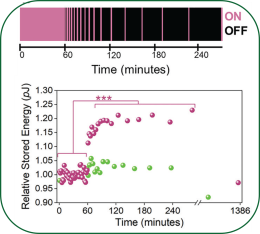
LTP generation in a lipid/oil/water system after applying electrical stimulation (purple trace)
Scientific Achievement
Application of an electrical stimulation training protocol to a phospholipid droplet interface bilayer (DIB) results in persistent synaptic plasticity in the form of long-term potentiation (LTP), an important component of learning and memory in the brain.
Significance and Impact
Even in the absence of peptides or proteins, LTP in lipid bilayers provides a model for the molecular basis of biological memory, as a therapeutic agent for brain diseases unresponsive to drugs targeting proteins, and for artificial neural network development
Research Details
- Electrical measurements were performed on DIBS consisting of nm-thick planar lipid bilayers that form on contact between lipid-coated aqueous droplets in oil.
- Electrical training consisted of a low-frequency sinusoidal voltage that induced structural rearrangements of the bilayer, generating long-lived LTP in the form of stored capacitive energy.
- Reversal of the voltage polarity (+/-) erased LTP.
H.L. Scott, et al., Proceedings of the National Academy of Sciences 119 (50), e2212195119 (2022). DOI:10.1073/pnas.2212195119


